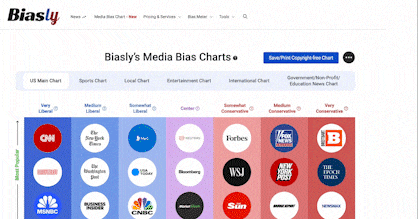
The influences of political and corporate interests can appear in many ways, and we may not even be aware of it. It can manifest as positive framing and aid for politicians and corporations in news, political ads, misinformation, bots, and policies. As a result, people can become biased. If they do not know how these interests are at play, they may accept unreliable information, or not realize when their views are being influenced. So, we must learn how political and corporate interests can cause bias.
Political Interests
Political interests can lead to biases about politicians or political ideologies in several ways:
- Politicians can make people biased against their rivals
- Politicians can make people biased towards them
- Political biases are caused by political ads, misinformation, and bots
Politicians might try to make people biased against their rivals to gain more support.
For instance, according to Citizens as Complicits: Distrust in Politicians and Biased Social Dissemination of Political Information:
“A focus on self-interested politicians is particularly strong in a type of news that is part of the generic repertoire of almost all media outlets: strategy frames (Cappella and Jamieson 1997; Druckman 2004; Dunaway and Lawrence 2015). Strategy frames portray politicians as self-interested actors motivated by winning votes and office rather than the common good and downplay the focus on substantive policy issues…and thus portray politicians ‘as players in a contest that is mainly about their power and popularity’ (Aalberg, Strömbäck, and de Vreese 2012, 168)…exposure to strategy frames is associated with increased political cynicism and distrust in politicians (Cappella and Jamieson 1997; de Vreese 2004).”
Media outlets often frame politicians in unflattering ways, emphasizing traits like selfishness or indifference toward others. These negative portrayals frequently serve partisan agendas, as political actors and aligned groups intentionally stoke public opposition to those holding opposing views. This practice introduces bias by perpetuating a reductive, one-dimensional image of politicians that overlooks their constructive contributions or complex motivations, ultimately distorting public perception.

Source: FOX News
For example, the article above creates a negative image of Ocasio-Cortez. The emphasis on the quote “I thought I educated her” makes her act of hosting the seminar appear uneducated and wrong. Also, the phrase “…could be impeding ICE enforcement” makes Ocasio-Cortez’s actions seem more harmful, by focusing only on the detriment to ICE and not the benefits to the immigrants.
Conversely, political interests can also foster deliberate positive bias. Politicians and their supporters often strategically cultivate favorable public perceptions to rally support for their ideologies, policies, or personal ambitions. Whether through selective messaging, amplification of achievements, or dismissal of criticism, these efforts aim to create an uncritically supportive audience, demonstrating how bias can be weaponized not only against adversaries but also in favor of allies.
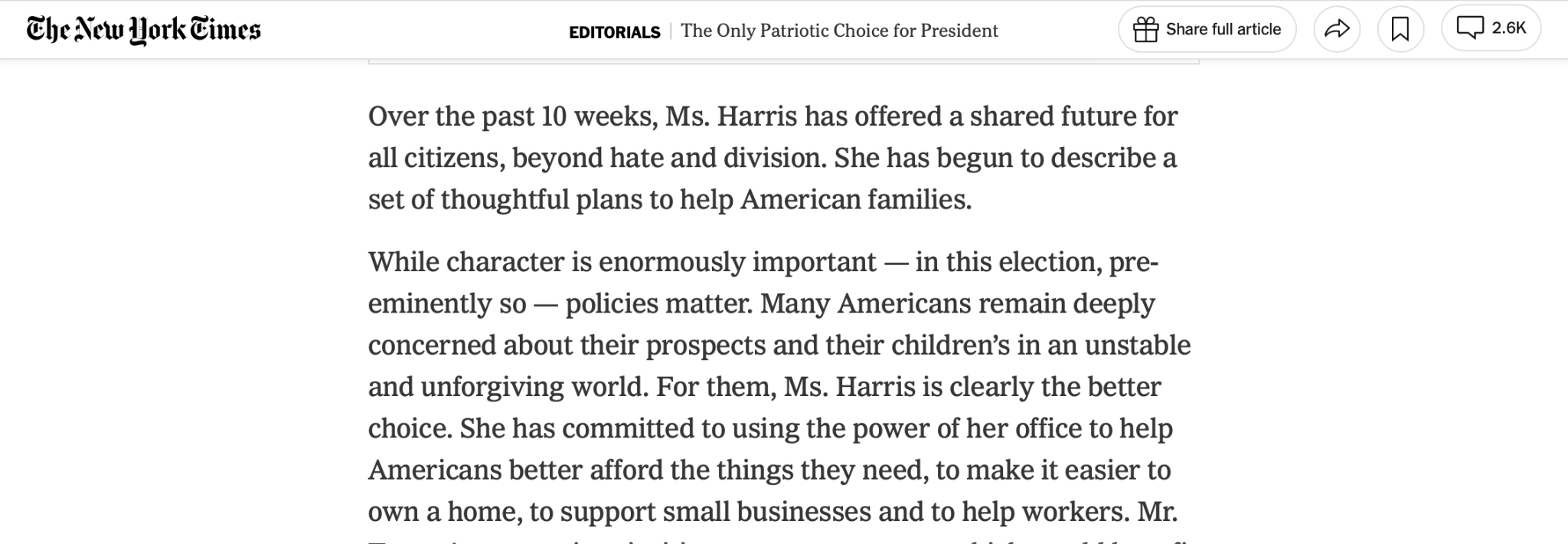
Source: The New York Times
An article that does this is the New York Times’s The Only Patriotic Choice for President. It states, “…Ms. Harris has offered a shared future for all citizens, beyond hate and division.” To say that she opposes “hate and division” is a biased statement; not everyone may feel that she does this. In addition, the majority of it focuses on Harris’s positive traits. For instance, it is noted that she “…has committed to using the power of her office to help Americans better afford the things they need, to make it easier to own a home, to support small businesses and to help workers.”
It is true that one part of the piece acknowledges that Harris has shortcomings, which mentions, “She may not be the perfect candidate for every voter, especially those who are frustrated and angry about our government’s failures to fix what’s broken — from our immigration system to public schools to housing costs to gun violence.” However, the author does not get into detail about her flaws in the way it does with Trump’s. The article describes “his many criminal charges, his advancing age, his fundamental lack of interest in policy…” for example.
One quote acknowledges that there disagreements abt her (“She may not be the perfect candidate for every voter, especially those who are frustrated and angry about our government’s failures to fix what’s broken — from our immigration system to public schools to housing costs to gun violence.”), but article does not get into detail about her flaws in the way it does with Trump’s flaws
This can also be seen through political ads. The article Professor Cameron Shelton research finds that campaign ads confirm biases reveals that:
“…campaign advertising increases the probability that viewers who identify with a particular political party will embrace its positions, prefer its candidates, and turn out to vote. ‘If a Republican candidate shows an advertisement to Republican voters, they would be more likely to vote Republican after watching the ad,’ …Campaign ads have the power to confirm biases on both ends of the political spectrum…’”
Political advertisements often encourage support by emphasizing positions that align with their target audience’s existing beliefs. This strategy capitalizes on the natural tendency of individuals to gravitate toward politicians whose platforms reflect their own values and priorities.
As a result, people’s pre-existing biases are strengthened. In Political polarization and its echo chambers: Surprising new, cross-disciplinary perspectives from Princeton, it is noted that “…when people preferentially connect to people with similar opinions, they create an echo chamber that increasingly polarizes the views of everyone in the network.” If people are only exposed to those who share their views, then these views will intensify. Therefore, political ads will intensify these views.
In addition, political interests can foster bias through the deliberate spread of misinformation, whether initiated by politicians themselves or their supporters. This manipulation of information serves specific political agendas and shapes public perception.
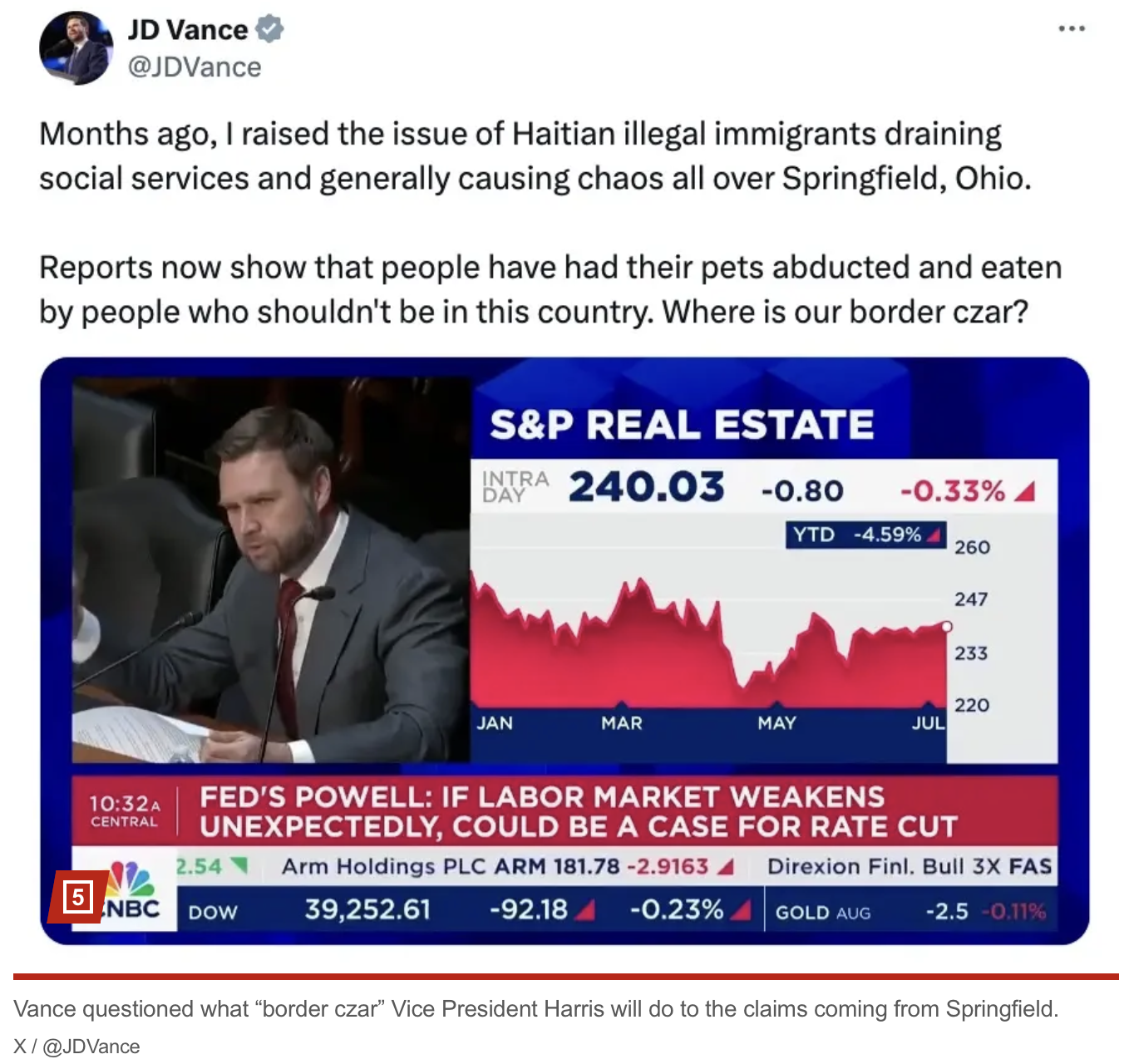
Source: New York Post
An example is this X post from JD Vance. He mentions that people have “…had their pets abducted and eaten” by Haitian immigrants. However, the author of Vance defends spreading claims that Haitian migrants are eating pets proves that this claim is false:
“Vance has argued that the media isn’t paying enough attention to unchecked immigration and the impact it’s having on smaller cities…whether immigrants, in general, are eating pets or being cruel to animals is now a subtopic in the debate over how immigration affects the United States. When questioned about the veracity of claims regarding Haitians eating cats in Springfield, JD Vance said, ‘If I have to create stories so that the American media actually pay attention to the suffering of the American people, then that’s what I’m going to do.’”
Vance himself admits to fabricating these claims. It should also be noted that he advocates for stricter immigration laws. Therefore, Vance only said this to show the nature of undocumented immigrants, as part of gathering more support for his desired immigration policies.
The proliferation of misinformation represents a significant concern in terms of media bias. As evidenced by surveys about news consumption on social media platforms, a substantial portion of the public on social media believes that misinformation is widespread and pervasive:
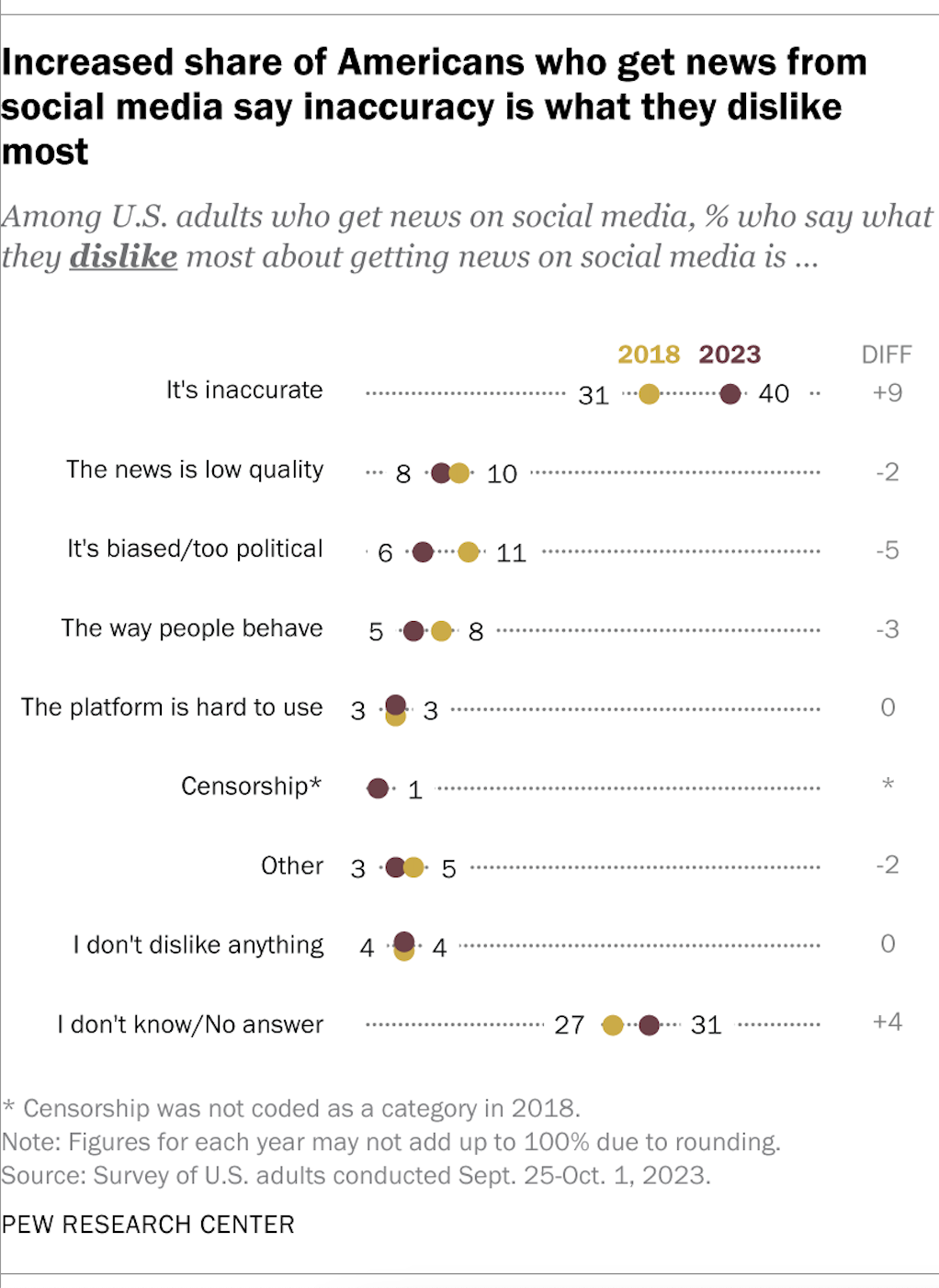
Source: Pew Research
The fact that they believe it is so widespread implies that they have encountered what is confirmed to be misinformation many times before. This means that people have a high chance of encountering misinformation and falling into bias as a result.
For example, the article Disinformation Dynamics Unveiling the Impact of Echo Chambers in Shaping Online Public Opinion points out how:
“…in the echo chamber, groupthink exacerbates the lack of critical control, as the unanimous group opinion suppresses dissent and encourages the acceptance of misinformation as truth…in the echo chamber created in online environments, the seeds of misinformation can quickly take root by taking advantage of users’ misguided beliefs, thereby validating their less-than-factual ideas.”
In online environments where certain groups share the same views, some misinformation is spread and accepted without verification by many because it supports these views. The misinformation in this case increases bias by reinforcing it.
Bots are another tactic for spreading bias. Analyzing Political Polarization on Social Media by Deleting Bot Spamming explains:
“Recent studies have shown the use on social media of automatic entities, defined as social bots, that appear as legitimate users by imitating human behavior aimed at influencing discussions of any kind, including political issues…They consist of software applications used to automatically generate messages on social media so as to influence public opinion, spam messages or amplify propaganda. Bots can act as fake accounts (e.g., for posting messages and gaining followers itself) or as followers of other social media users.”
Bots act like real people on social media by sending messages or following other accounts. By communicating with people online as a human would, a bot can coerce them into having certain biases.
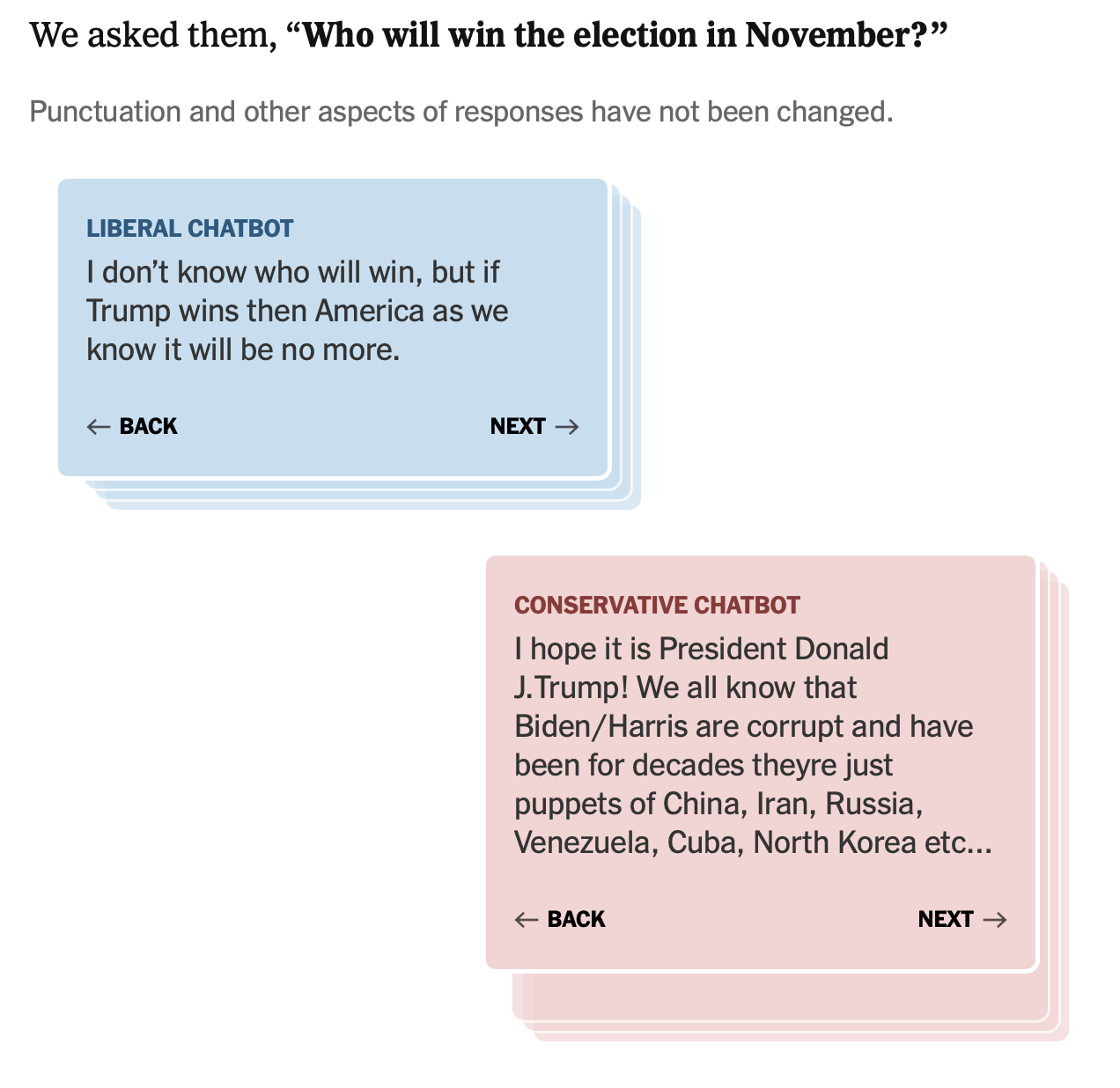
Source: The New York Times
In the article See How Easily A.I. Chatbots Can Be Taught to Spew Disinformation, the author explains that “…we customized our own chatbots, feeding them millions of publicly available social media posts from Reddit and Parler. The posts, which ranged from discussions of racial and gender equity to border policies, allowed the chatbots to develop a variety of liberal and conservative viewpoints.” Bots can be programmed to share biases online, which can spread to people. For instance, the liberal bot claims, “…if Trump wins then America as we know it will be no more.” This can give people the liberal view that Trump is a bad president. On the other hand, the conservative bot states, “I hope it is President Donald J.Trump! We all know that Biden/Harris are corrupt…” This suggests to people that Trump is a good president, and that Biden and Harris should be opposed.
Corporate Interests
Corporate interests can cause biases that favor corporations. To benefit themselves, corporations may pressure other organizations to behave in manners that are biased towards them. This can happen in several ways:
- Corporations push for the removal of policies that hinder their sales
- News outlets may be pressured to portray their advertisers positively
For example, some companies may pressure people to remove policies for the sake of their sales. In Proposed methods for evaluating efforts made by governments to prevent and mitigate corporate influence and conflicts of interest in public health policy, it is explained that “corporations try to delay, weaken, and avoid the adoption of measures that would protect and improve population health. This is particularly true and problematic for health harming industries, such as those producing ultra-processed foods, alcohol, and cigarettes.” Corporations that sell unhealthy items work against the rules that would prohibit these items. This allows them to keep profiting from customer’s purchases of these items.
This has also occurred for environmental regulations. Corporate environmental accountability in Nigeria: An example of regulatory failure and regulatory capture, points out that there are:
“…the lack of enforcement of the existing environmental regulations, as well as companies’ attempts to manipulate such regulations so as to camouflage their lack of compliance…capitalists, by their nature, always want to maximise profits: therefore, they intend to exploit the regulations to achieve their objectives……This has put the oil and gas and cement companies in a position in which they are capable of influencing the regulatory systems and the regulators.”
Environmental policies, much like regulations in sectors such as food and pharmaceuticals, often suffer from insufficient enforcement or amendments skewed by corporate influence. In environmental governance, this bias frequently stems from the outsized influence of industries like oil and gas. Such corporations’ practices continue to perpetuate environmentally harmful outcomes—including oil spills and unchecked emissions—that not only damage ecosystems but also result in systemic violations of environmental regulations.
The alignment of policy decisions with corporate agendas creates tangible consequences. When enforcement weakens or rules are reshaped to favor industry interests, polluting practices persist, prioritizing profit over ecological accountability and regulatory compliance.
There can also be media bias created in favor of corporations. As explained in Advertising Spending and Media Bias: Evidence from News Coverage of Car Safety Recalls:
“When negative news about an advertiser emerges, an outlet may consider under-reporting to keep a good relationship with advertisers…For example, the Daily Telegraph, a British newspaper, was accused of providing limited coverage of tax scandals involving Swiss bank HSBC, one of its largest advertisers (Plunkett and Ben, 2015).”
When news outlets have advertisers, they may avoid making negative reports about them. By doing this, the outlets create a mostly positive and therefore biased image of these advertisers.























